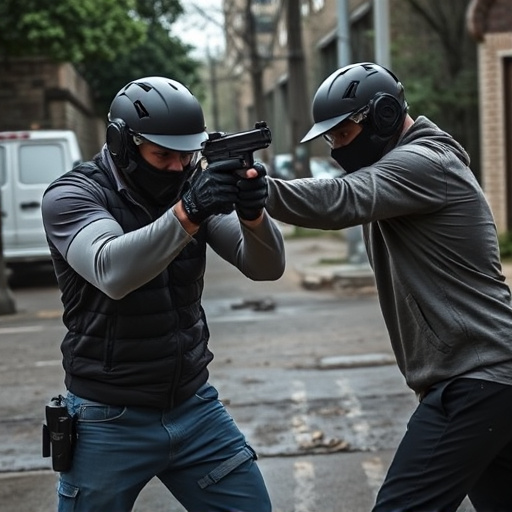Pepper spray is a powerful tool for defending against aggressive dogs, temporarily incapacitating them with capsaicin. Effectiveness varies by dog size and aggression, so responsible use as a last resort after trying other methods is crucial. When selecting a pepper spray, choose products designed for animal deterrence, prioritize higher OC concentrations, and consult experts. Correct usage techniques include aiming at the face or eyes from arm's length for 2-3 seconds, then creating distance. Legalities and safety precautions vary by location, so checking regulations before use is essential. Responsible use involves precise application, minimal exposure, proportionate force, secure storage, awareness of wind patterns, and regular maintenance.
Personal safety is paramount when facing aggressive dogs, and a pepper spray defense against dogs can be an effective deterrent. This comprehensive guide explores the power of pepper spray as a personal safety tool, delving into its composition, effectiveness against canine aggression, and crucial usage techniques. We’ll navigate legal considerations and precautions to ensure responsible use, empowering individuals with knowledge for self-defense in unexpected encounters.
- Understanding Pepper Spray: Its Composition and Effectiveness Against Dogs
- Choosing the Right Pepper Spray for Personal Safety When Facing Dog Aggression
- Correct Usage Techniques: How to Maximize the Impact and Ensure Your Safety
- Legal Considerations and Safety Precautions: Responsible Use of Pepper Spray
Understanding Pepper Spray: Its Composition and Effectiveness Against Dogs
Pepper spray, a powerful defense mechanism, is designed to incapacitate and deter potential threats, particularly in situations involving aggressive dogs. Its primary active ingredient is capsaicin, a natural compound derived from chili peppers. This chemical irritates the eyes, nose, and respiratory system, leading to temporary blindness, coughing, and difficulty breathing. When used against dogs, pepper spray can effectively disrupt their behavior, providing an opportunity for escape or safety.
The effectiveness of pepper spray against dogs varies based on factors such as the dog’s size, aggression level, and the distance at which it’s deployed. For smaller breeds, a single burst may be enough to stop an attack. However, larger dogs might require multiple applications. It’s crucial to use pepper spray responsibly and only as a last resort, ensuring that all other de-escalation methods have been exhausted.
Choosing the Right Pepper Spray for Personal Safety When Facing Dog Aggression
When considering a pepper spray defense against dogs, it’s crucial to choose a product designed for animal aggression. Not all pepper sprays are created equal; those intended for personal safety against humans may not pack enough punch to deter a dog. Look for sprays specifically labeled for dog defense, as these often have higher capicity oleoresin capsicum (OC) concentrations—the active ingredient responsible for the burning sensation and temporary incapacitation.
Additionally, consider factors like range and effectiveness. A spray with a longer reach can help maintain distance from an aggressive dog, while a formula that remains effective in windy conditions is ideal for outdoor situations. Always check user reviews and consult experts to ensure you select the most suitable pepper spray defense against dogs for your specific needs.
Correct Usage Techniques: How to Maximize the Impact and Ensure Your Safety
When using pepper spray as a defense against dogs, understanding and practicing correct usage techniques is paramount to maximize its impact while ensuring your safety. First, ensure you have a clear target in mind—often the dog’s face or eyes. Aiming for these areas will cause the most discomfort and disrupt the animal’s ability to breathe or see effectively. Hold the canister at arm’s length, slightly higher than eye level, and activate the spray when the dog is within range. A quick burst of 2-3 seconds is usually sufficient; remember, pepper spray causes temporary but intense irritation, giving you time to retreat or defuse the situation.
After deployment, create distance between yourself and the dog as quickly as possible. Pepper spray can be blown back towards you by wind or the dog’s movements, so don’t stay in the immediate area. Additionally, be mindful of surrounding environments; avoid spraying near flammable materials or in enclosed spaces, as the spray’s heat and chemicals can cause unintended consequences. Regularly practicing these techniques will help you remain calm and confident when facing a potential attack, ensuring your safety and that of others around you.
Legal Considerations and Safety Precautions: Responsible Use of Pepper Spray
When considering a pepper spray defense against dogs, it’s crucial to understand legal considerations and safety precautions surrounding its use. Laws regarding pepper spray vary by jurisdiction, so checking local regulations is essential before purchasing or carrying any type of spray. Some areas restrict its use solely for law enforcement, while others permit civilians under specific conditions.
Safety precautions extend beyond legality. Responsible use involves aiming carefully to minimize exposure of yourself and others, using only as much force as necessary, and keeping pepper spray out of reach of children and pets. It’s also important to store the spray in a secure, accessible location, and be aware of potential wind patterns that could blow the spray back towards you or bystanders. Regular maintenance and checking expiration dates ensure the spray remains effective when needed.
When faced with dog aggression, learning how to use pepper spray effectively can serve as a powerful tool for personal safety. By understanding its composition, choosing the right product, and mastering correct usage techniques, individuals can protect themselves in potentially dangerous situations. However, it’s crucial to navigate legal considerations and practice safety precautions when carrying and using pepper spray, ensuring responsible and proportional defense against dogs. Remember, knowledge equips you with the means to defend yourself and your loved ones effectively.
